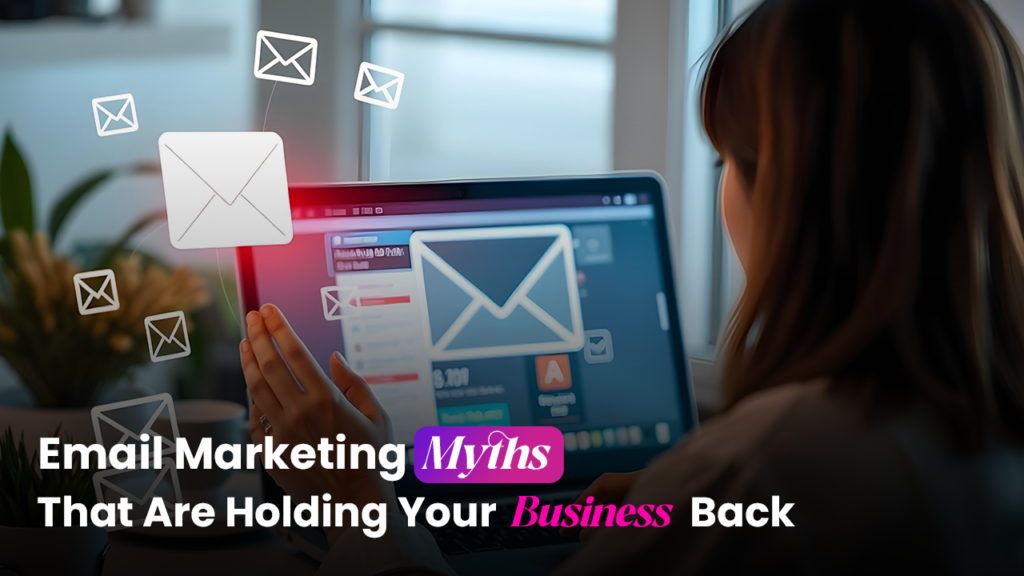Introduction
Email marketing is a clever method of communicating with your clients. Updates, offers, and
news can be sent directly to their inbox. It is inexpensive, quick, and simple to complete. It helps
a lot of businesses, big and small, expand. However, some people continue to have doubts
about it.
Yes, there are many myths about email marketing. These myths stop people from using it the
right way. Some say email is old. Some think people don’t open marketing emails. Others
believe social media is better. But the truth is different. One of the most effective tools is still
email. When done correctly, it produces excellent outcomes. It increases sales, fosters trust,
and helps you connect with the right people.
In this blog, we will talk about the most common myths. We will show you why they are wrong.
And we will tell you what to do instead. So, if you think email marketing does not work, think
again. Read this blog and clear your doubts. Let’s break those myths.
Myth 1: Email is dead
“No one checks emails anymore,” many people say. “The new king is social media.” However,
that is untrue.
Every day, people check their emails. They check emails more than social media. Think about it.
You need an email ID for everything — signing up, shopping, job alerts, banking, and more.
Even young people, who are active on Instagram and YouTube, still check their emails daily for
updates and offers. Businesses send receipts, shipping info, and special deals through email.
It’s a trusted source of communication.
Stats show that email marketing has a higher return on investment (ROI) than any other
platform. For every ₹1 you spend, you can earn up to ₹40 back. That’s huge! No one can take it
away. You are not at the mercy of changing algorithms or platform rules. You can reach your
audience directly.
Truth: Email is not dead. It is still growing. You just need to do it right.
Myth 2: People don’t open marketing emails
Yes, not all emails get opened. But that doesn’t mean people ignore them all.It depends on what
you send.Your email will be opened if it is valuable. They will click if the subject line is
compelling. It will be read if it is helpful.
Your subject lines should be succinct, concise, and attention-grabbing. Share a benefit or pose
a query. Add the person’s name to make it uniquely yours. Emojis can be added if they enhance
your brand. An excellent subject line is crucial. Emails should be brief, straightforward, and
unambiguous. Include a kind offer or gratuity. Make use of cordial language. Don’t use
“no-reply”; always send from a real name.
Additionally, send it at the appropriate time. The majority of people check their emails either
after lunch or in the morning. To monitor your open rates, use tools. You’ll gain a better
understanding of what works and what doesn’t.
Truth: People open emails if they find them useful and well-timed.
Myth 3: Buying email lists is a good idea
This is one of the biggest mistakes.
Buying a list may sound easy.However, you are unknown to the majority of those people. They
didn’t subscribe to your email list. Thus, you might be flagged as spam. Additionally, your email
account might be blocked if a lot of people do that. It damages the image of your brand as well.
The majority of purchased lists contain numerous outdated or phony email addresses. Some
might even be automated. Emailing them degrades your deliverability. It damages your
reputation and lowers your open rate. Growing your list gradually is preferable. Make use of
sign-up forms on your social media accounts and website. Offer a discount, a complimentary
guide, or early access in exchange.
Focus on quality, not quantity. A small, real list is better than a big fake one.
Truth: Never buy email lists. Build your list with real, interested people.
Myth 4: You should send emails to everyone
This sounds right, but it isn’t. Each person on your list is unique. Offers appeal to certain people.
Others are looking for tips. There are both new and returning customers. It might not be
effective to send them all the same email.
Individuals will grow disinterested or believe the message is inappropriate for them. They might
unsubscribe or cease reading your emails. Email segmentation is crucial for this reason. Sort
your list by location, age, interest, or purchasing patterns. Next, send the appropriate email to
the appropriate group.
Although it takes a little longer, the results are better. Emails that are personalized are more
likely to be opened and clicked. People feel you care. Even using their name makes a
difference. Add value to their inbox, not clutter.
Truth: Don’t email everyone the same thing. Segment and personalize for better results.
Myth 5:People will get annoyed if you send them too many emails.
Many believe that sending emails often will drive people away. But that’s not always true.
People get annoyed when emails are boring, not helpful, or sent without a reason. But if your
emails are valuable, people will look forward to them. Consistency is key. If you send emails
once a week or twice a month with useful tips, offers, or updates, people stay connected. They
begin to trust you.
Also, give people the option to choose how often they want to hear from you. Weekly, bi-weekly,
or monthly — let them decide. Always keep the content fresh, simple, and helpful. Use clear
language, a friendly tone, and good design.
Truth: Good emails, sent at the right time, never annoy. They build trust and grow your brand.
Myth 6: Unsubscribes are always bad
Seeing someone unsubscribe can feel disappointing. But it’s not always a bad thing. It means
that person is not interested anymore — and that’s okay. You only want people on your list who
care about your content. It keeps your list healthy and focused.
Also, unsubscribing helps you save money if you’re using a paid email platform. Why pay to
send emails to people who don’t want them? A few unsubscribes are normal. Don’t stress over them. Instead, focus on the ones who stay. Give them better value, offers, and content they
enjoy.
Use unsubscribes to learn. Was it the content? The timing? Try to improve each time.
Truth: Unsubscribes clean your list. They help you focus on the right people.
Myth 7: Email design is more important than the content
A beautiful email catches the eye. But good looks alone won’t help if the message is weak.
People open emails to learn something, get offers, or find solutions. If your content is boring or
unclear, even the best design won’t save it.
Design enhances, not replaces, the content. Strong words in a simple, clean layout are more
effective than a fancy, useless design. Make an effort to write concise, useful, and
understandable content. Make use of headers, bullet points, and plain language. Only include
pictures when necessary.
Make sure your email looks good on mobile too, but never forget — the message matters most.
Truth: Design is important, but content is what keeps readers interested and makes them act.
Myth 8: Email marketing is only for sales
Many people think email marketing is just for selling products. But it’s much more than that.
You can use emails to build trust, share tips, tell stories, and educate your audience. Share
behind-the-scenes, customer stories, or updates about your brand. These build a strong bond
over time. Not every email should ask people to “buy now.” Sometimes, just sharing value is
enough. It keeps your brand in their mind. So, when they are ready to buy, they’ll choose you.
You can also use emails for feedback, surveys, event invites, and thank-you notes. This keeps
your audience engaged.
Truth: Email is not just for sales. It’s for building long-term relationships.
Myth 9: You don’t need to test your emails
Some think testing emails is a waste of time. But that’s far from true. Testing helps you know
what works. A small change in the subject line, image, or button can lead to big results. Without
testing, you’re just guessing.
Try A/B testing — send two versions of the same email to see which one performs better. You
can test the time of sending, layout, words, or even colors. Sometimes, it looks good on one but
bad on the other.
Truth: Testing helps you improve your emails, get more clicks, and make better decisions.
Myth 10: Email marketing gives instant results
Some people expect email marketing to deliver quick results, but it’s a long-term strategy.
It takes time to build trust and get people to act. The first few emails may not result in immediate
sales or clicks, but they help build a relationship with your audience. Maintaining consistency
and nurturing your subscribers is the aim. Your emails will gain a devoted readership over time,
which will improve open rates, increase engagement, and ultimately boost conversions.
Don’t give up if you don’t see instant success. Be patient, track your progress, and keep
improving.
Truth: Email marketing works over time, not instantly. Consistency is key.
Conclusion
Email marketing is full of power. But many myths hide its true value. Some say it’s old. Others
think it doesn’t work. These wrong ideas stop many businesses from using it well.
Now, you know the truth. Email is not dead. People do open good emails. Buying lists is bad.
And you should always send the right message to the right group. Don’t fear sending more
emails. Just focus on giving value. Let some people go if they are not interested. That’s fine.
And always test your emails before you send them to all. Email marketing is not magic. It takes
time, care, and honesty. But once you do it right, it gives back more than any other channel.
So stop believing those myths. Start using email the smart way. Build strong connections. Offer
help, not just products. And watch your business grow.
At the Digital House, we believe in the power of data-driven marketing strategies that not only
dispel these myths but also turn email marketing into a tool for growth. Whether you’re just starting out or looking to refine your current campaigns, our team of experts is here to help you
craft effective email marketing strategies that deliver real results.

